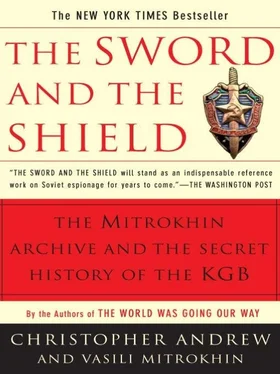The MARINO cache consisted of a cleft at the foot of an ancient tree which had been expanded into the root system of the tree.
The cache was located at a point 6 km along the Via dei Laghi after leaving Rome. Proceed along the Rome-Albano road, turn left into the Via dei Laghi, and continue for 6.3 km. From the 6 km milestone, the road begins to turn sharply just in face of the Marino hamlet. In the middle of the bend, two unmetaled village tracks go off to the left and the right of the road. Between the track to the right of the road and the road itself there is a sector overgrown with tall bushes. Among these bushes there is one ancient tree 25 m from the road. The MARINO cache is at the foot of this tree in the root system on the side opposite to the road, at a depth of 25 cm from the surface.
Two containers are wrapped in cellophane and placed in a metal sweet tin measuring 18 × 10 × 4 cm, the edges of which have been stuck down with insulating tape.
The objects have been covered with earth and a stone placed on top. 82
(The cache was emptied by the Rome residency on February 7, 1970.) 83
FOR REASONS OF public safety it is impossible to publish the locations of any of the KGB radio and arms caches which have not been cleared, since an unknown number are booby-trapped or in otherwise dangerous condition.
TWENTY-THREE
SPECIAL TASKS
Part 2: The Andropov Era and Beyond
On becoming chairman of the KGB in 1967, Andropov immediately announced his intention to revive KGB “special actions” as an essential tool of Soviet policy during the Cold War. The FCD, he declared, “must take the offensive in order to paralyze the actions of our enemies and to get them involved in a struggle in conditions which are unfavorable to them.” 1Two years earlier dissatisfaction with the recent record of the Thirteenth Department, which was responsible for FCD special actions, had led to its reorganization as Department V. 2Following Andropov’s call for a new “offensive to paralyze the actions of our enemies,” the main priority of Department V became “special actions of a political nature”—the peacetime use of sabotage and other forms of violence in the furtherance of Soviet policy. 3Line F officers in residencies were instructed to show greater ingenuity in devising special actions in which the hand of the KGB would be undetectable. All of the newly devised sabotage proposals employed the same standardized coded jargon. Each act of sabotage was termed a “Lily” ( Liliya ), the explosive device a “Bouquet” ( Buket ), the detonator a “Little Flower” ( Tsvetok ), the explosion of the device a “Splash” ( Zaplyv ) and the saboteur the “Gardener” ( Sadovnik ). 4
The most important special action being planned at the beginning of the Andropov era was in Greece, where a group of army colonels seized power in April 1967, suspended parliamentary government and declared martial law. The Greek Communist Party (KKE) was driven underground and its leaders temporarily lost touch with Moscow. In July 1967 the KGB was formally instructed by the CPSU Central Committee to renew contact with the underground Party (a task it had doubtless already begun) and to give it “political and material assistance.” 5The “material assistance” included both financial subsidies, usually handed over to Party representatives in Budapest, 6and help in preparing for guerrilla warfare. The Centre decreed that Department V’s main priority for 1968 should be to set up sabotage and intelligence groups (DRGs) on Greek territory to prepare for an uprising against the military regime. 7Department V also made preparations for possible guerrilla operations in Italy. The leaders of the PCI were seriously afraid of an Italian military putsch on the Greek model and had requested Soviet assistance in preparing the Party for the possibility that, like the KKE, it would have to transform itself into an illegal underground movement. 8
In 1968, all KGB residencies were sent operational letters headed “Recommendations for Creating the Necessary Conditions on the Territory of a Potential Adversary for Special Group [DRG] Operations in an Emergency.” The letter to the resident in Athens, Ivan Petrovich Kislyak (codenamed MAYSKY), added: “It is not possible that the course of events will in practice require us to assist local progressive forces in the near future, and we must therefore make preparations for this in advance.” 9The Centre issued instructions that all locally recruited DRGs operating in Greece were to be headed by KGB agents, but that this was to be concealed from other members of the groups. 10In 1968 the illegal PAUL was sent to Greece with orders to select “runways” ( doroshki ) for the landing of airborne Soviet DRGs and bases—“beehives” ( ulya )—from which to operate, as well as to check the suitability of those sites identified earlier. “Runway ALFA,” reconnoitered by PAUL, was located in the southern part of the Thessalia plain, about forty kilometers north-west of the town of Lamia. “Runway BETA” was on the north-west of the Thessalia plain, four or five kilometers south of the Kalambaka settlement. The wooded hilly districts of Belasitsa, Piri and Sengal were chosen as areas suitable for smuggling agents and equipment across the Bugarian—Greek border. 11
In August 1968 the Bulgarian DS confidently informed the Centre that it was capable of overthrowing the Greek junta with the assistance of one of its agents, whom it identified as the former head of a Greek intelligence agency. The Bulgarian Central Committee had approved the proposed coup d’état in Athens and instructed the leadership of its intelligence service to coordinate plans for it with the KGB and the CPSU Central Committee. 12The KGB files seen by Mitrokhin do not explain why the Bulgarian proposal was turned down. There were, however, at least three probable reasons. The Centre may well have assessed the risks of failure more highly than the Bulgarians. The Politburo, which at almost the moment the Bulgarian proposal reached it was deciding on the invasion of Czechoslovakia, was doubtless disinclined to give its simultaneous approval to a risky coup attempt in Greece. Further complications were caused by the split in the Greek Communist Party which, after the suppression of the Prague Spring, divided into the pro-Soviet KKE and the Eurocommunist KKE-es. Brillakis (codenamed SEMYON), who had hitherto been one of the KGB’s chief contacts in the underground Greek Party, refused further meetings with the Athens residency in protest at the Warsaw Pact invasion of Czechoslovakia. 13
Though the KGB continued to channel large amounts of money into the KKE, 14it seems to have made little progress in setting up DRGs on Greek soil. The main material successfully smuggled across the Greek—Bulgarian border was not sabotage equipment into Greece but the archives of the KKE which were taken in the opposite direction. Weighing 14 tons, filling 1,598 packages and four crates, guarded by thirty Greek Communists, they were transported from Bulgaria to Romania and thence to the Soviet Union, where they were deposited for safekeeping in the town of Ivanovo. 15
AMONG DEPARTMENT V’S most ambitious proposals for special actions during 1968 was an operation to distract Western opinion from the suppression of the Prague Spring by sabotaging a major oil pipeline, codenamed ZVENO (“Link”), near the Austrian end of Bodensee Lake, which was believed by the Centre to carry 10 million tons of oil a year between Italy and West Germany. By breaching the pipeline at the point where it crossed the Rhine canal, Department V calculated that it could pollute the Bodensee, and thus contaminate the main source of drinking water on the West German—Austrian frontier. To carry the explosive, the Vienna residency purchased four Western-manufactured 1-liter thermos flasks, as well as ten ballpoint pens—presumably to conceal the detonators. The scapegoats for the environmental disaster caused by the explosion were to be Italian extremists allegedly retaliating for acts of sabotage carried out by South Tyrol terrorists.
Читать дальше











